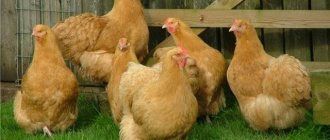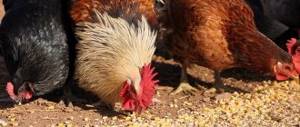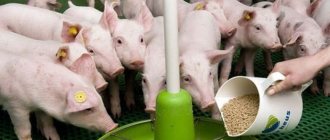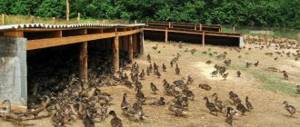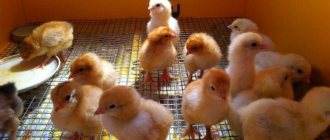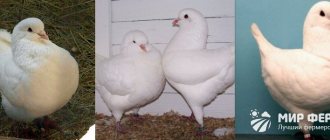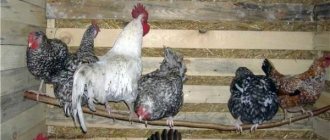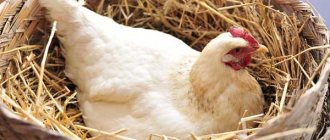Features of feeding broilers with compound feed
Feeding with compound feed has become increasingly popular in recent years. Due to the fact that they contain almost everything that a chicken needs, such feeds can easily replace other food for birds. The food is presented in the form of a granulated mix of various crops, vitamins and proteins.
Did you know? The first sample of mixed feed was produced in 1813, but was not developed because it was perceived as a by-product.
pros
- Feeding with compound feed has several advantages:
- combined feeds allow birds to gain weight for slaughter as quickly as possible;
- the feed contains a full range of vitamins and amino acids necessary for chicken.
Minuses
- The disadvantages of compound feeds include:
- high cost;
- the need for a large amount of water and control over its consumption by birds;
- significant presence in the market of low-quality producers.
Types of feed for different periods of growing up and their composition
There are three power plans:
- two-phase, including start and finish;
- three-phase, including start, growth and finish;
- four-phase, including pre-start, start, growth and finish.
The most common is three-phase and therefore it will be considered.
"Start"
This stage also includes the pre-start stage in three-phase feeding. The starting stage begins from the moment the chick hatches and lasts up to 30 calendar days with two-phase feeding and up to 15–18 calendar days with other schemes.
A high-quality starter has the following composition:
- 36% - cereals;
- 30% - soybean meal;
- 21% - millet;
- 5.5% - oil and rapeseed cake;
- 5% - proteins, chalk, table salt, soda, phosphates;
- 2.5% - corn gluten and molasses.
Thanks to the starter feed, bone tissue and muscles are formed, the immune system is strengthened, which ensures a daily weight gain of 30 g. The number of meals is 6 times. The amount of food is from 25 g to 90 g, depending on age.
"Height"
This type is evenly distributed between start and finish with two-phase feeding and from the 15th–18th calendar day to the 37th with other feeding schemes and is aimed at mature chickens.
It includes the following components:
- yeast;
- phosphates;
- fish and meat flour;
- soybean and sunflower meal;
- enzymes and amino acids;
- calcium carbonate.
Breeding broilers does not require a lot of free space, so they can even be raised in cages. Learn how to make your own broiler cages.
The percentage of feed components may vary depending on the manufacturer. At this stage, the birds have already formed, and therefore there is a net weight gain, amounting to up to 50 kg daily. Food is taken 3-4 times a day in a volume of 90 to 150 g, depending on the breed.
"Finish"
Finish feed is given to chickens starting from the 30th day with a two-phase diet and from 15–18 days with other nutrition schemes and continues until the chicken is slaughtered. It includes:
- 45% - wheat;
- 24% - cereals;
- 16% - soybean meal;
- 6% - fish meal;
- 5% - sunflower cake;
- 3% — sunflower oil;
- 1% - limestone flour, salt, minerals and vitamins.
The main purpose of this feed is to gain weight for slaughter. It is taken twice a day and gives a daily gain of 50 g.
Compound feed is an indispensable food for broilers
Compound feed for broilers is a balanced complex for feeding these birds. This raises a completely legitimate question: how to choose the right composition of mixed feed and wouldn’t it be easier to make it yourself? In this article we will try to find the answer to these questions.
Advantages and disadvantages of using mixed feed
Eating mixed feed as the main food allows birds to reach maximum weight in the shortest possible time . The fact is that meat breeds of chickens are slaughtered for meat quite early, after about 1.5–2 months. Therefore, the farmer is faced with the task of providing chickens with a complete and balanced diet. Doing this without a comprehensive diet is very problematic.
But there are several flaws in such a practical and convenient feeding scheme. Firstly, not all producers of feed for broilers conscientiously fulfill their responsibilities. Natural sources of protein and amino acids are replaced in production with synthetic analogues.
And synthetics do not mix well with other components of feed. Therefore, many farmers have probably observed such a picture when, after feeding, white powder remains in the trays. This is protein and amino acids. Therefore, when using such feed, young animals may gain weight poorly.
Secondly, high-quality and balanced nutrition for broilers is quite expensive. For comparison, grain will cost twice as much.
And even adding vitamins and mineral supplements to regular food is much cheaper. Therefore, many farmers prefer not to spend money to buy ready-made food, but prefer to make it themselves.
Optimal composition of feed for broilers
The meat production of domestic chickens requires high-calorie nutrition. Therefore, when purchasing combined feeds, you need to pay attention to their composition. Compound feed for broilers must contain:
- proteins;
- vitamins and mineral components;
- protein (its source is grass flour);
- corn;
- feed wheat.
Scheme for using combined feeds
There is a special table according to which broilers are usually fattened. It comes in two types and both methods are quite successfully used in poultry farming.
Option #1
It consists of two phases, in other words, the life of the bird is divided in half, and at each stage a certain diet is used. From birth to a month of life, a starter kit is used, after which the finishing feed is used.
Option No. 2
In large farms and poultry farms, broiler fattening is divided into three stages. Chickens up to three weeks old are given a pre-start set of feed. This helps strengthen the immune system of young animals. Further feeding occurs according to the previous scheme.
The table helps to keep track of what stage of fattening the broiler is at. Accordingly, it is easier for the farmer to select feed and monitor how the bird gains weight.
How to prepare compound feed with your own hands
In order to prepare compound feed with your own hands, you need to calculate its quantity. They do this according to the following scheme: count the number of chicks and multiply the resulting number by 25.
Chickens under two weeks of age need 25 grams of feed per day. Please note that with age, the amount of feed consumed by birds increases; before slaughter, broilers consume about 150 grams per day.
After some simple calculations, you can start preparing the feed. In order to provide broilers with the necessary amount of vitamins, corn and cake are used. The presence of protein will ensure the use of fish or bone meal. Grass meal can serve as a source of protein. Alfalfa works well.
Starter Kit Recipe
At the initial stage of feeding, you will need the following ingredients:
- 48% corn or corn flour;
- 19% meal or sunflower cake;
- 13% wheat (can be ground);
- 7% bone meal;
- 5% compressed yeast;
- 3% grass meal;
- 1% feed fats.
Finishing Kit Recipe
Immediately before slaughter, birds must consume more calories, so the components remain virtually unchanged, but their dosage changes:
- 45% corn flour;
- 17% sunflower cake (you can use meal);
- 17% bone meal;
- 13% crushed wheat;
- herbal flour and chalk - one percent each;
- 5% yeast;
- 3% feed fats.
The best producers of compound feed
To choose a good feed, you need to know the manufacturers whose products are of high quality and are in demand among consumers.
"Rozovka"
Produced in the Donetsk region, Rozovsky compound feed occupies a strong position in the market due to strengthening the immunity of livestock, high quality ingredients and an affordable price.
"Provimi"
Provimi compound feeds are beginning to be in increasing demand due to their high quality and innovation - the company invests a lot in conducting a wide range of research aimed at improving the quality of feed.
Did you know? The world's three largest feed producing countries are the People's Republic of China (183 million tons/year), the USA (177 million tons/year) and Brazil (66 million tons/year).
"Shchedra Niva"
The products of Shchedra Niva have proven themselves due to the presence in the feed composition of not only all the necessary elements, but also vitamin supplements. In addition, the company's feeds demonstrate the highest food-to-weight conversion compared to competitors. The product is complete and therefore suitable at all stages of a chicken’s life.
"Purina"
Purina is one of the oldest companies on the market, its activities began in the 19th century. Since then, the company has developed and today all the accumulated experience is reflected in the compound feeds produced by Purina. Its strengths are its balanced composition, containing all the elements necessary for the growth of chicken, the absence of antibiotics and the presence of enzymes that promote digestion. The availability of feed for all stages of feeding allows you to support birds at different ages. There are no special requirements for food intake.
Separately, it is worth noting the PK-6 compound feed. This food is the most popular for the finishing phase of feeding. This is explained by the fact that it was specially developed to complete feeding - almost two-thirds of the composition comes from wheat and cereals (46% and 23%, respectively), and the premix contains all the necessary vitamins.
How to make feed for broilers with your own hands
If the purchased combination feed is too expensive or none of the feeds on the market are suitable for chickens, you can prepare the feed yourself. The proposed recipe is designed to produce one kilogram of feed.
Composition and proportions
The table contains data on the ingredients required for the manufacture of feed:
| corn | 260 g |
| wheat | 150 g |
| barley | 100 g |
| sunflower cake | 120 g |
| fish meal | 100 g |
| meat and bone meal | 80 g |
| stern chalk | 10 g |
| feed fat | 20 g |
| grass flour | 40 g |
| feed yeast | 30 g |
| shell | 40 g |
| premix | 20 g |
| vegetable oil | 30 g |
Important! Melted lard or chicken fat can be used as feed fat.
Step-by-step cooking instructions
Preparing feed includes the following steps:
- Use a scale to measure the required amount of each ingredient.
- Pour the ingredients into a bucket or other suitable container.
- Mix the ingredients thoroughly and pass through a granulator (if you have one).
- Let the mixture stand for 10 minutes.
Video: Preparing broiler feed
How to make the best mixture with your own hands
Making feed yourself is much cheaper. In addition, having prepared your own compound feed, you have one hundred percent confidence in its quality and naturalness of the ingredients.
To make the mixture yourself, you need a grain crusher and a mixing container.
sifting the mixture
Homemade compound feed recipe Start
- 48% corn;
- 18% sunflower meal;
- 14% wheat;
- 6% meat and bone or fish meal;
- 3% grass meal;
- 1% feed fat (can be replaced with fish oil)
- 0.1% table salt;
- 10% BVMK (protein-vitamin-mineral concentrate)
The recipe was compiled taking into account the use of BVMK 10%. If another concentrate is purchased, for example, BVMK 6%, then its quantity is calculated according to the instructions for use.
Recipe No. 2:
- 47% corn;
- 19% sunflower cake;
- 12% wheat;
- 7% meat and bone or fish meal;
- 2% grass meal;
- 2% dry skim milk;
- 1% feed fat;
- 0.1% table salt;
- 10% BVMK.
The grain is passed through a crusher, the remaining ingredients are added (all of them in the form of a free-flowing powder). Then the homemade starting mixture must be thoroughly mixed. This is a very important condition for good food.
Household grain crusher
Mixture composition Growth
- 48% corn;
- 18% sunflower cake or meal;
- 10% wheat;
- 7% meat and bone or fish meal;
- 2% feed yeast;
- 2% grass meal;
- 1% feed fat;
- 1% dry skim milk;
- 0.1% table salt;
- 10% BVMK10%.
Recipe No. 2:
- 48% corn;
- 15% sunflower cake or meal;
- 8% wheat;
- 7% meat and bone or fish meal;
- 6% barley;
- 2% feed yeast;
- 3% grass meal;
- 1% feed fat;
- 1% chalk;
- 0.1% table salt;
- 10% BVMK10%.
Feed proportions - mash Finish
- 45% corn;
- 19% sunflower cake or meal;
- 13% wheat;
- 4% peas or soybeans;
- 3% feed yeast;
- 3% feed fat;
- 2% grass meal;
- 1% chalk;
- 0.1% table salt;
- 10% BVMK10%.
At the final stage of broiler fattening, the mash may not include meat and bone and fish meal - a source of animal protein necessary for the growth of the body.
Of course, homemade feed will not meet the established state standards, but the naturalness of the ingredients compensates for this shortcoming.
How to feed broilers correctly
To properly feed broilers, you need to know a few basic rules and how much food birds should eat.
Basic feeding rules
The basic feeding rules include:
- Combined feeds are consumed with minerals and vitamins - the exception is when chickens are injected with antibiotics.
- The amount of feeding and food intake are selected based on the age of the bird.
- The number of meals decreases as birds grow older.
Daily norm and diet
As already mentioned, the nutrition of birds is calculated based on their age. On average, chicks eat 6 times a day for the first two weeks of life, eating an average of 10–20 g at a time (the amount of food increases as the chicks grow older). For the next 10–15 days, food is taken 3 times a day, 40 g of food at a time. At the final stage, food is taken twice a day in a volume of 80 g.
Features of feed
The main feature and advantage of broiler chickens is their rapid growth. Usually they are not kept at home for more than 3 months, because this time is more than enough for the bird to grow and gain maximum weight. Further maintenance is considered inappropriate. In order for a broiler to have a significant weight, the feed for it must be very nutritious, contain a lot of proteins and protein, as well as minerals and vitamins so that the bird remains healthy.
Factory-made feed is an expensive type of feeding, especially since you are not always able to control the quality of purchased feed. If you buy unsuccessful feed, you risk the health of your livestock and can incur considerable losses if broilers are the basis of your business. Therefore, many farmers prefer to prepare their own feed; you will see today that there is really nothing complicated about it. The basis of feed for broilers is nutritious corn and wheat, it is thanks to them that the birds will gain valuable muscle mass.
Compound
Many breeders divide feed for broilers into starter feed, which is given to birds up to two weeks of age, then they give growth feed and, a couple of weeks before slaughter, they switch to finishing feed. That is, the composition and formulation of feed for different age groups of broilers will vary somewhat. These are the products that are included in the feed and that you will need throughout the entire fattening period of your broilers:
- Corn and wheat;
- Cake and meal;
- Barley and oats;
- Meat and bone meal and fish meal;
- Lump fat, chalk, salt.
Feeding standards
In addition to variations in the composition of feed, it is natural that its standards will change. As the bird grows, its need for food will only increase. Overfeeding or underfeeding is not very beneficial for any age. Therefore, try to adhere to the approximate age norms; how much feed a broiler eats at different ages can be seen in the table below.
| Bird age | Amount of required feed, g |
| From birth to 2 weeks | 10-25 |
| From 2 weeks to 1 month | 50-120 |
| From 1 month to slaughter | About 150 |
In the video below you can see what alternative recipe for preparing broiler feed is offered by an experienced breeder and how good his birds look.
How to give correctly?
Factory-made or home-prepared feed can be given both in crumbly form and as part of mash. Some breeders criticize this type of feeding, such as mash, suggesting that they simply pour the grain mixture into the birds and provide a sufficient amount of water. In principle, such advice sounds quite rational, because grain is a familiar and natural type of food for any bird, including broilers, and the bird eats it with pleasure. It is very good if you are not too lazy to periodically germinate grain for your birds or yeast it. The yeasting procedure is not difficult to carry out at home, but this method significantly increases the nutritional value of the feed.
We recommend this method of yeasting: pour regular baker's yeast (10 g per 2 liters of water) into a saucepan with warm water. Then 1 kg of prepared or factory-made feed is poured into the liquid and left for 6-9 hours, remembering to periodically stir the mixture. After this, the yeasted feed is ready for your birds to eat.
Farmers who raise broilers professionally sometimes prepare granulated feed, which reminds us of what is sold in poultry farms or veterinary stores. It is believed that feed in the form of granules is better absorbed by birds, however, to achieve this effect at home, you need expensive equipment - a granulator. You can, of course, try to make it yourself; how it should look in the end is shown in the video above.
What feed is best for broilers?
As already noted today, different age groups of broilers are given different feeds. Starter feed for meat birds is PK6-1. This food is based on crushed corn and also contains wheat, peas and barley. These components have a beneficial effect on the formation of the chick’s skeleton and have a positive effect on the functioning of the gastrointestinal tract. Starter feed is given to broilers up to two weeks old, then they are transferred to PC6-2, which is given during the period of intensive growth of the bird.
Starting from one month of age, broilers can be transferred to finishing feed labeled PK6-3. An alternative to the factory-listed compound feeds, as well as an option made at home with your own hands, can be pork feed. Sometimes breeders with large farms choose a universal feed that would suit several types of poultry or livestock at once. Pork feed is recognized as the most universal, as it contains fiber, chalk and salt in optimal proportions. It can serve as feed for your broilers if you add a source of calcium and additional vitamins.
